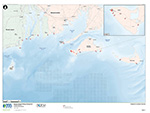Summary
In response to stakeholder interest regarding visual impacts from potential future renewable energy development within the Massachusetts and Rhode Island Wind Energy Areas, BOEM undertook a project to develop daytime and nighttime photomontages and 24 hour day-through-night videos to simulate what turbines might look like if these six lease areas were fully developed. For 24 observation points located in Massachusetts and Rhode Island, the study considered different seasons, times of day, and weather conditions. A meteorological report detailing the weather and visibility conditions over a 10-year period was prepared as part of this study and incorporated into the simulations. It is also available below.
As explained below, BOEM’s visual simulations are not representative of the actual offshore wind energy facilities that may be constructed in the Massachusetts and Rhode Island Wind Energy Areas. Although BOEM does not expect this level of development to occur in the foreseeable future, this visualization study will still assist BOEM in conducting public scoping and addressing cumulative impacts as we receive proposals for wind energy facilities in the Massachusetts and Rhode Island Wind Energy Areas.
How will actual offshore wind facilities differ from these visual simulations?
At the time of the visualization study BOEM was not considering the approval of a specific project within the Massachusetts and Rhode Island Wind Energy Areas; therefore, the visual simulations illustrate hypothetical projects. The hypothetical projects (i.e., full build out of the Massachusetts and Rhode Island Wind Energy Areas) were designed to represent a commercially-scaled and technically feasible scenario that was consistent with industry trends regarding operating capacity, wind turbine size, spacing and configuration in the summer of 2014. Per BOEM’s guidelines, project-specific visual simulations would be prepared by the lessees and submitted with actual Construction and Operations Plans (COPs). BOEM anticipates that these projects would be much smaller in scale than the full build out, cumulative scenario depicted in these simulations. BOEM will then conduct project specific environmental and historic preservation reviews based on the information included in the lessee's COP and visual simulations. See Guidelines for Information Requirements for a Renewable Energy Construction and Operations Plan.
BOEM’s visual simulation study considered a larger number of smaller turbines compared to what is currently being considered by the Massachusetts and Rhode Island lessees. Specifically, the visual simulations modeled turbines 510-575 feet tall (blade tip), while the Massachusetts and Rhode Island lessees are currently considering turbines 595-650 feet tall (blade tip) or taller. In addition, BOEM’s visual simulations modeled 1,600 turbines spaced 1,500 meters apart (slightly under one mile), while the lessees are currently considering spacing of one mile apart or greater, which would result in fewer turbines than modeled.
In addition, the nighttime simulations available on this webpage are based on the Federal Aviation Administration’s (FAA) guidance at the time (Advisory Circular 70/7460-1K, Obstruction Lighting and Marking, February 1, 2007). After the development of the night visual simulations, the FAA issued new guidance (Advisory Circular 70/7460-1L, Obstruction Lighting and Marking, December 4, 2015). Therefore, these nighttime simulations model a single, red light per turbine and do not take into account the new standard - dual, red lights for turbines over 499 feet tall. In addition, FAA’s new guidance allows for the use of Aircraft Detection Lighting Systems (ADLS), which are sensor-based systems designed to detect aircraft as they approach an obstruction or group of obstructions. ADLS automatically activate the appropriate obstruction lights until they are no longer needed by the aircraft, reducing the impact of nighttime lighting on nearby communities.
Instructions for Viewing the Visual Simulations
Photographic Simulations: The simulations are intended to be viewed as large printed photomontages viewed on curved stands at a distance of 16 inches. The images viewed on this website are digital representations of the photographic simulations. The visibility of the turbines on images projected on a computer screen will depend on the scale at which the image is being viewed. Simply put, zooming in on the image will over-represent visibility and, conversely, zooming out will minimize visibility of turbines.
Video Simulations: If viewed on a computer monitor, use the highest screen resolution available. The simulated image is at the proper perspective when viewed at 23.5 inches from the eye, or at a distance of approximately twice the image height.
Visual Simulations
- Daytime Panoramic Views
- Fred Benson Town Beach, Block Island, RI (#1)
- Point Judith Lighthouse, Narragansett, RI (#2)
- Narragansett Town Beach, RI (#3)
- Beavertail Lighthouse, Jamestown, RI (#4)
- Brenton Point State Park, Newport, RI (#5)
- Second Beach, Middletown, RI (#6)
- South Shore Beach, Middletown, RI (#7)
- Horseneck Beach State Reservation, Westport, MA (#8)
- Aquinnah (Gay Head) Lighthouse, MA (#9)
- Squibnocket Beach (Squibnocket Farm Road), Chilmark, MA (#10)
- Wasque Point, Martha's Vineyard, MA (#11)
- Tom Nevers Field, Nantucket, MA (#12)
- Lookout HIll (Tower Road), Gosnold, MA (#13)
- South Beach State Park, Edgartown, MA (#14)
- Madaket Beach Dunes, Nantucket, MA (#15)
- Lucy Vincent Beach, Chilmark, MA (#16)
- Tribal Administration Building, Aquinnah, MA (#17)
- Aquinnah Cliffs Overlook Area, Aquinnah, MA (#18)
- Edwin D. Vanderhoop Homestead, Aquinnah, MA (#19)
- Top of Circle Park Area, Aquinnah, MA (#20)
- Philbin Beach, Aquinnah, MA (#21)
- Moshup Beach, Aquinnah, MA (#22)
- Gay Head Community Baptist Church, 2 Meeting House Way, Aquinnah, MA (#23)
- Peaked Hill, Chilmark, MA (#24)
- Videos Depicting 24-hour Day/Night Cycle
Meteorological Report
This effort also included an analysis of the meteorological conditions along the coast of Massachusetts and Rhode Island. This analysis was an integral part of the visualization study. The report can be found through this link: www.boem.gov/Final-Meteorological-Report/.



